As soon as it was unveiled on stage in October, I started looking forward to getting the new iMac in for review. See, my main machine is a 13-inch MacBook Air, which I mostly love. But sometimes I want a bigger screen for watching movies, or more processing power when I'm dealing with photos or video, or a half-decent GPU when I feel like playing games. The new iMac promised all that, in a newly slim package that would fit nicely on my desk.
Then there's the Mac mini, which has occupied a spot in my living room for years. Mine's old, and showing its age – it can barely handle high-def video, and even stumbles on some basic tasks. Apple updated that in October too, bestowing upon its tiny desktop a new processor and the new Fusion Drive.
I've been counting pennies ever since, waiting to see if it's truly time to upgrade my setup. I've now had a chance to live with both of Apple's new desktops, but am I buying? Should you?

This year's iMac appears to have undergone the computer version of elective cosmetic surgery – it doesn’t look different, just better. It’s still very much an iMac, with a big black bezel surrounding a big screen, an aluminum chin below with a glossy Apple logo in its center, and a tilting aluminum stand sticking out of the back. But it’s smaller, lighter, and thinner than ever. Apple’s claim of it being 5mm thin is a bit misleading — the back bulges out from the razor-thin edges almost like an old CRT television, and in the center it’s about four times as thick. It's almost an optical illusion, astonishingly thin if you look at it from the front but much fatter if you catch it at the wrong angle. It's not quite as light as the HDTV-like Vizio All-in-One PC, but it’s still thinner than most computer monitors you’ll find, and there’s, you know, a whole computer inside. It’s incredibly sleek — almost every single person who saw it on my desk started stroking it absent-mindedly. That part was weird, but it just goes to show how good-looking this thing is.
| Dimensions (in.) | Weight (lb.) | |
|---|---|---|
| iMac (21.5-inch, late 2012) | 17.7 x 20.8 | 12.5 |
| iMac (21.5-inch, mid 2011) | 17.7 x 20.8 | 20.5 |
| iMac (27-inch, late 2012) | 20.3 x 25.6 | 21.0 |
| iMac (27-inch, mid 2011) | 20.3 x 25.6 | 30.5 |
Since a 5mm edge doesn’t leave room for much of anything, the iMac's other parts had to get shifted around a bit. For starters, there’s no optical drive in the iMac anymore. That decision makes some sense on laptops, where every ounce and millimeter matters, but I miss it here. The iMac's screen should make it a perfect device for watching movies, and its huge hard drive should make a perfect storage machine for your photos or movies, but without an optical drive, both my Blu-ray collection and the decade's worth of home movies sit untouched. The SD card slot has also been moved to the back, joining the headphone jack in the row of other ports (four USB 3.0, two Thunderbolt, and one Gigabit Ethernet). Having every single port on the back is a little annoying, but the SD card slot is particularly bad since I pop cards in and out so often after taking pictures.
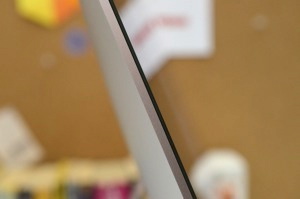
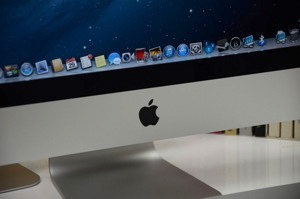

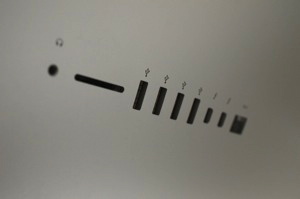

I’ve always loved the iMac’s speakers – you rarely get integrated speakers with decent bass response and clear sound, and the iMac used to offer both — but in the newer, slimmer model, they’re actually a step backward. Mids and highs sound great, and the down-firing speakers are loud enough to fill a room, but there’s absolutely zero bass response. That makes everything sound a little tinny, and songs lose some punch. This is the first iMac in a while I’d recommend buying with a set of external speakers.
Compare this: Apple's new iMac vs. the Windows 8 competition
The smaller, cheaper iMac comes with a 21.5-inch, 1920 x 1080 display; on the 27-inch behemoth, you get a 2560 x 1440 panel that's matched only by the Dell XPS 27. Both work out to just over 100ppi, and if you get close to the screen you can definitely see individual pixels, but at normal using-a-computer distances, they look crisp and sharp. The IPS panels are the same as in last year’s iMacs, but they’re better integrated now — Apple says that by laminating the display to the glass it reduced reflections up to 70 percent, and indeed the glare problems that beset so many displays are much less present here, though there's still some reflection and glare. The improved manufacturing also makes whatever’s on the screen feel closer to you, almost like things are jumping out of the panel. The display's glossy bezel, which houses its HD FaceTime camera, is actually the most reflective part of the whole machine now.
I have to say, I was really surprised to see how much better the screen could be without a single change to the actual technology — but hey, I guess plastic surgery can work wonders. Both screens have fantastic color reproduction, are remarkably (like, blindingly) bright, and have near-180-degree viewing angles. The wide viewing angles give you another way to defeat glare, by tilting the screen forward or backward — unfortunately that's about all the iMac's stand lets you do, but it should always be possible to find a good angle for the display.
The iMac got more attention this go-round than the Mac mini, but it's still just an iterative upgrade, and is missing a few things I'd really like to have — a more adjustable stand, an HDMI port, and alas, that optical drive. But even last year's model was the best-looking all-in-one on the market, and this year's version might be the most powerful, so why mess with a good thing?
Mac mini hardware
While the iMac got lifts here and tucks there, the Mac mini decided it was happy with its body. Its look hasn't changed in a couple of years, and I see no reason why it should: it's simple and beautiful, and how many ways are there to make a rounded rectangle anyway? The whole package is 2.7 pounds, 1.4 inches tall and 7.7 inches square, and should fit just about anywhere you need it to. It sits on a tiny built-in stand, which helps both with airflow and access to the Wi-Fi antenna on the bottom. That bottom stand twists off, revealing the RAM slots — you can upgrade the RAM yourself, easily, but everything else about the mini is designed to be touched by Apple hands only. There's a tiny LED on the front that blinks when the mini is turned on, next to a small circular IR port — other than that and the Apple logo, all you'll see is aluminum. It's probably the best-looking thing sitting on my desk, and looked pretty good sitting next to my TV too.
Complainers be damned, Apple's sticking to its guns and leaving an optical drive off the mini as well. I'm one of those complainers, and I'd be thrilled to be able to toss my external disc drives and my gigantic Blu-ray player in favor of the mini, but no dice — Apple wants to make very certain that no one mistakes the mini for a home theater PC. In retaliation, I ripped my Blu-rays onto another computer, transferred them to the Mac mini, and watched them on my TV anyway, which somehow felt like a victory. Sort of.
I don't even think Apple changed its production of the Mac mini chassis; the company just upgraded a few new internals and let the assembly line keep chugging. It also downgraded one part, the GPU, but I'll get to that in a minute. The port configuration hasn't changed a bit, right down to the Firewire port on the back — the company's evidently not as happy to let its own standards go. Joining it on the black rear rubber panel are Thunderbolt, HDMI, and Gigabit Ethernet ports, plus four USB 3.0 slots, audio in/out, an SD card slot, and a power adapter and button. My only wish is that the power button were a little easier to find: it's hidden on the curved edge, and can be tough to track with your finger, so I sometimes had to jam my head behind my monitor to turn on the computer. It's not a good look for me.
A small package, but it packs a wallop




Software and performance
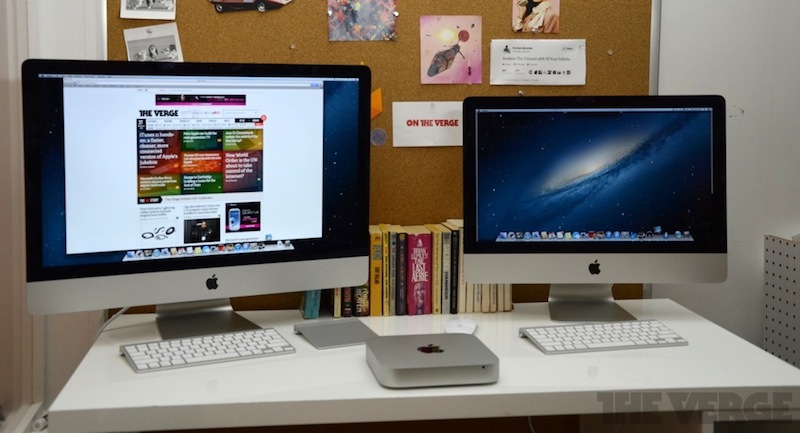
Both new Mac desktops run OS X 10.8.2, which is the most current version of Mountain Lion. We've reviewed Mountain Lion in full already, and there's really nothing to add here except a word of advice: get a Magic Trackpad to go with whichever device you get. Mountain Lion continues Apple's march toward the iOS-ification of OS X, which means gestures rule the interface. Having the trackpad makes the whole setup feel more advanced and more native.
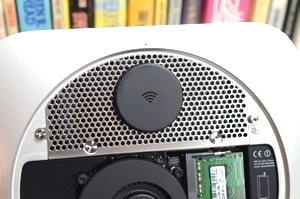
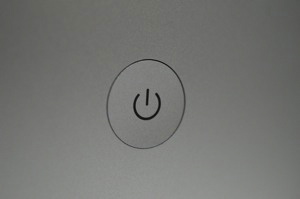
As much faster as you'd expect a new generation to be
The iMac ships with Apple’s Bluetooth keyboard and a Magic Mouse, which you can (and should) swap for a Magic Trackpad when you check out. Both are quite good, and any Mac user should be immediately comfortable. Assuming the mini was the same, I turned its box inside out looking for them, but it comes alone – so add a keyboard and Magic Trackpad to the purchase price unless you already have the peripherals.
I tested high-end configurations of both iMac sizes — a 3.1GHz Core i7 processor and 16GB of RAM on the 21.5-inch model, and 3.4GHz and 8GB on the 27-incher. Performance is unsurprisingly fantastic: even with dozens of tabs running in Chrome, and a bunch of apps and games playing simultaneously, neither iMac showed any hint of struggle. Left 4 Dead 2 played flawlessly on both machines at the highest settings and their native resolutions — I was a little worried about playing at 2560 x 1440, but it was perfectly smooth. Likewise, Portal 2 ran at 60 frames per second on both, at their native resolution. The whole line of iMacs comes with discrete Nvidia Kepler graphics, and they’re absolute workhorses. I'm throwing harder and harder games at the iMac and it doesn't mind a bit, but I'll be sure and update here if I manage to defeat its GPU. I used the GeForce GT 650 M graphics on the 21.5-inch model, and the GTX 675MX chip on the 27-inch machine — you can configure the larger iMac with an even more powerful 680MX chip, but that'll cost you.
| GeekBench | 32-bit |
|---|---|
| iMac (21.5-inch, late 2012) | 12,447 |
| iMac (27-inch, late 2012) | 12,828 |
| Mac mini (late 2012) | 10,819 |
| iMac (27-inch, mid 2011) | 8,449 |
| Mac mini (mid 2011) | 6,523 |
| MacBook Pro with Retina display (15-inch) | 11,965 |
It's worth noting that the 15-inch MacBook Pro with Retina display scored nearly the same on our Geekbench test as the two new iMac models. The MacBook Pro is now a remarkably powerful device, able to do a lot of the professional-grade things once reserved for desktop PCs — it's also considerably more expensive than the new iMacs. But it's worth considering not only which desktop you want to buy, but whether or not a desktop is even the right kind of computer for you anymore.
The Mac mini I tested came with a 2.3GHz Core i7 processor, 4GB of RAM, and a Fusion Drive. It’s not nearly the gaming machine the iMac is, or even as good as the last-gen mini — Apple swapped AMD Radeon HD GPUs for integrated Intel HD 4000 graphics, and that’s a significant step down. Still, it’s a very capable general machine: it played 1080p footage without a hitch on my HDTV, and handled even the heaviest version of my workday just fine. It’s a little frustrating that you can’t buy a mini with a discrete GPU even if you want to, but it’s still plenty powerful for the price.
I worried a bit about noise and heat, especially on the iMacs, where the fans have been consolidated to a tiny port behind the stand. It was never really an issue, though — I could always tell when the fans kicked on, but the machines never got overly hot or especially loud even when I was playing a game or editing video. As long as there's a place for the computers to vent, you'll be fine.
Fusion Drive
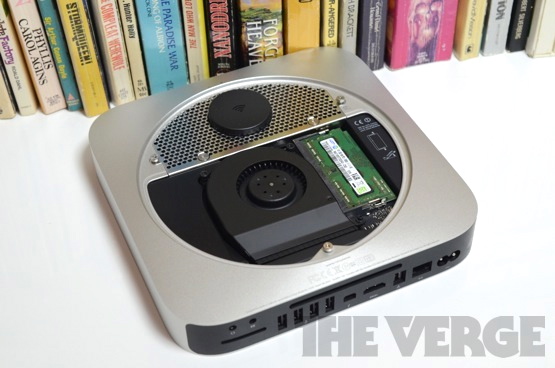
There's only one technological upgrade in this year's desktop lineup that's more than just a keeping-up-with-progress change. Apple's new Fusion Drive is the company's attempt to offer it all: the speed of solid-state storage and the inexpensive capacity of a spinning hard drive.
This kind of setup has long been possible to create yourself, but Apple's trying to make it totally seamless and automatic. Basically, here's how it works: the first 128GB of data you put onto the hard drive of your iMac or Mac mini (including the OS itself) goes onto the computer's SSD. For most people, the 1TB spinning drive will be totally superfluous because 128GB is a lot of storage, but if you do fill it up, anything you add after goes onto the regular hard drive. Then, if you access something from the spinning disk often enough (Apple reps say two or three times in a reasonably short period), it gets moved to the solid-state drive so it can be accessed and used more easily. Apple's software figures out which data on the SSD you haven't accessed in a while, and moves it to the larger drive to make room for the files you need.
It seems to work, too. The first clue came when I copied 400GB of movies, music, and TV shows from an external drive — it absolutely flew for the first 100GB or so, at which point I noticed a pretty significant slowdown in the copy speeds. Then I added an iPhoto library to the drive, knowing it would be stored off the SSD. I opened it a couple of times over the next hour, and by the third or fourth time noticed it loading significantly faster. The SSD’s biggest benefits are definitely faster boot times — the new iMac boots completely in about 15 seconds — and general system speed, but even working with regular files I noticed the difference between hard drive and SSD. The drive works just as it should, and especially if you're coming from a hard drive-based machine, the Fusion Drive feels blisteringly fast.
It's a very good idea, and is well-executed on both the Mac mini and the iMac. But it doesn't come cheap.
Apple didn't invent the idea, but it nails the execution
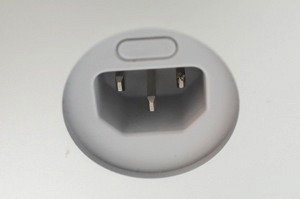
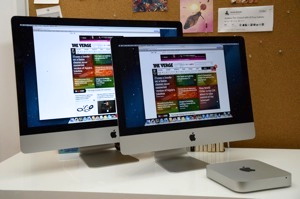
Configurations
You'll pay a LOT for the Fusion Drive — more than you should

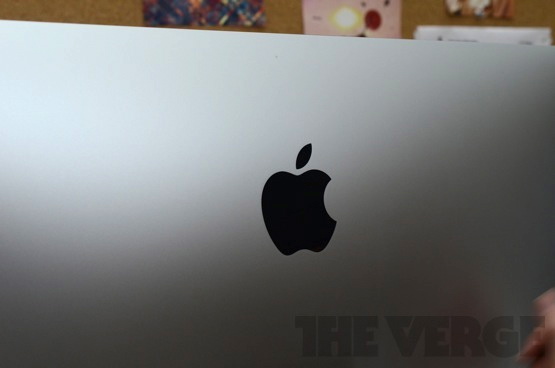
If you buy the base-level, cheapest model of either the iMac or the Mac mini, you'll miss out on some of the best features — like the Fusion Drive. The $599 Mac mini gets you a 2.5GHz dual-core Intel Core i5 processor, 4GB of RAM (which you can upgrade yourself, likely for less than it costs to buy more when you buy the machine), Intel's Integrated HD 4000 graphics, and a 500GB hard drive. $799 buys bumps those specs up to a 2.3GHz quad-core processor and a 1TB hard drive. But here's where it gets weird: to get a Fusion Drive, you have to buy the $799 model, despite the fact that the $599 mini seems eminently capable of running the drive as well. Then you have to pay a $250 premium for the Fusion Drive (which essentially just adds a 128GB SSD to the spinning drive you already get), meaning the cheapest Mac mini with a Fusion Drive is $1,049. 128GB SSDs surely aren't costing Apple $250 a pop, and there's no good reason for requiring the quad-core model in the first place — it all makes the $450 premium on the mini is a seriously tough pill to swallow.
$1,299 gets you a 21.5-inch iMac with a 2.7GHz quad-core Core i5 processor, 8GB of RAM, Nvidia GeForce GT 640M graphics, and a 1TB hard drive. For $1,499, you get a 2.9GHz processor and the slightly better GT 650M Nvidia graphics. To get a Fusion Drive, you have to buy the $1,499 model and spend an extra $250 on the drive itself. The fact that the iMac has a quad-core processor across the board makes the high-end requirement even harder to justify.
The 27-inch iMac starts at $1,799, for a 2.9GHz processor (the same as on the more expensive 21.5-inch model), 8GB of RAM, a 1TB hard drive with 7200rpm instead of 5400 on the other models, and even better graphics chips. This is the only one of Apple's three new desktops that doesn't force a processor bump to get the Fusion Drive — you just pay the $250. That means the cheapest Fusion Drive-capable 21.5-inch iMac is $1,749, and the cheapest 27-inch model will cost you $2,049. That's some serious cash, especially when neither the technology nor the hardware have to be so elitist.
Still the best all-in-one device out there, but the door is open for Windows 8
There's this great video on YouTube of a guy in Starbucks, playing a game on his iMac. It takes him forever to pack everything up when he's leaving — the mouse, the keyboard, the hulking desktop PC — but apparently the guy needed to play World of Warcraft on his iMac, and he needed his coffee too. Having used the new iMac, I don't in any way endorse using the machine as a laptop replacement, but I kind of get it — it's light and thin enough to almost be movable, and the screen is so good I'd never want to game on anything else if I could avoid it.
The display is really the only unequivocated improvement in the new model, and it’s a big one. The sleeker, slimmer design is great, but it causes a couple of problems and forces a few unfortunate compromises. Yes, it’s faster, but only enough to keep up with the Joneses — equal performance can definitely be had elsewhere. There’s no question this is the best iMac yet, but of course it is; Apple doesn’t have a habit of making its good products worse. If you weren’t in the market for a new all-in-one desktop, the iMac’s not suddenly so much more appealing that you absolutely have to have one now, but if you’re looking for a desktop PC there’s still no better option.
For now, anyway. I can't help but think Apple's left the door open here for Windows 8. Microsoft's new OS works beautifully on a big screen, and if a manufacturer can build an all-in-one with an equally gorgeous screen and svelte design, some of the media-friendly features the iMac lacks, and even throw in a touchscreen, I'd take a long, hard look before buying an iMac. HP's Spectre One does the design well largely by aping the iMac, and Dell's XPS 27 offers all the features I want — but I have yet to see the combination of design, features, and horsepower the iMac offers. I hope someone gets it all right soon, whether it's Apple or not.
Still the best all-in-one device out there, but the door is open for Windows 8
There's this great video on YouTube of a guy in Starbucks, playing a game on his iMac. It takes him forever to pack everything up when he's leaving — the mouse, the keyboard, the hulking desktop PC — but apparently the guy needed to play World of Warcraft on his iMac, and he needed his coffee too. Having used the new iMac, I don't in any way endorse using the machine as a laptop replacement, but I kind of get it — it's light and thin enough to almost be movable, and the screen is so good I'd never want to game on anything else if I could avoid it.
The display is really the only unequivocated improvement in the new model, and it’s a big one. The sleeker, slimmer design is great, but it causes a couple of problems and forces a few unfortunate compromises. Yes, it’s faster, but only enough to keep up with the Joneses — equal performance can definitely be had elsewhere. There’s no question this is the best iMac yet, but of course it is; Apple doesn’t have a habit of making its good products worse. If you weren’t in the market for a new all-in-one desktop, the iMac’s not suddenly so much more appealing that you absolutely have to have one now, but if you’re looking for a desktop PC there’s still no better option.
For now, anyway. I can't help but think Apple's left the door open here for Windows 8. Microsoft's new OS works beautifully on a big screen, and if a manufacturer can build an all-in-one with an equally gorgeous screen and svelte design, some of the media-friendly features the iMac lacks, and even throw in a touchscreen, I'd take a long, hard look before buying an iMac. HP's Spectre One does the design well largely by aping the iMac, and Dell's XPS 27 offers all the features I want — but I have yet to see the combination of design, features, and horsepower the iMac offers. I hope someone gets it all right soon, whether it's Apple or not.
A safe, iterative upgrade — but it's still unbeatable at what it does
The Mac mini took two steps forward this year, but it also took a small step back. The processor is better, the hard drive is larger and the SSD improves the machine's overall functionality, but Apple’s decision to remove the discrete GPU really eliminates the mini as a possibility for gamers. It’s a tiny, beautiful, versatile PC that remains an excellent way to get a Mac for less than $1,000, and it’s kept its home next to my TV, but it’s mostly the same as it ever was – and it’s not as good as it could be.
:format(webp)/cdn.vox-cdn.com/uploads/chorus_asset/file/12799637/DSC_3384-hero.1419979042.jpg)
:format(webp)/cdn.vox-cdn.com/uploads/chorus_asset/file/12799637/DSC_3384-hero.1419979042.jpg)
Share this story